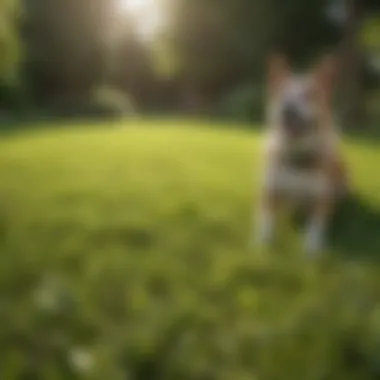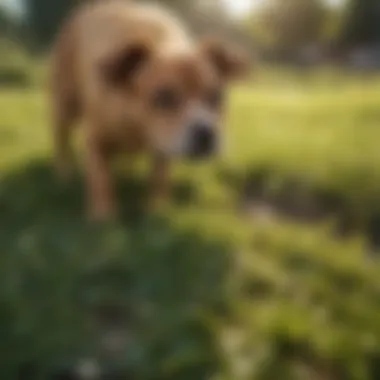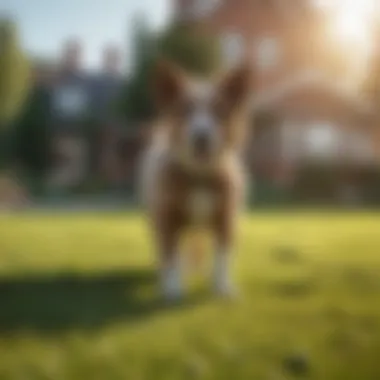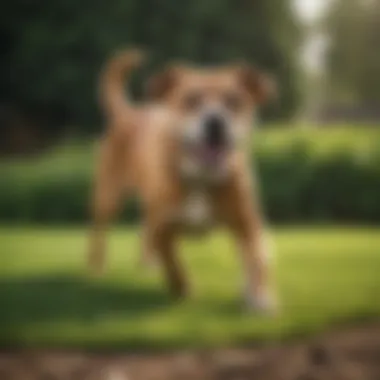Effective Strategies to Prevent Dog Urine from Yellowing Grass


Intro
Maintaining a vibrant lawn can be a challenging task for pet owners, especially when faced with the detrimental effects of dog urine. Understanding the components of dog urine and its impact on grass health can provide insight into effective strategies to mitigate this issue. This article offers a blend of science and practical solutions tailored for conscientious pet owners looking to keep their lawns lush and green.
Animal Overview
Common Names
The domestic dog, known scientifically as Canis lupus familiaris, is one of the most beloved pets worldwide. These animals are valued for their companionship, loyalty, and various utility roles in society.
Scientific Classification
- Kingdom: Animalia
- Phylum: Chordata
- Class: Mammalia
- Order: Carnivora
- Family: Canidae
- Genus: Canis
- Species: Canis lupus
Geographic Range
Dogs have been domesticated globally and now inhabit diverse environments, from urban to rural areas. This wide-ranging distribution reflects humans' various lifestyles and preferences, allowing dogs to thrive in most climates.
Impact of Dog Urine
Dog urine is rich in nitrogen, and while nitrogen is beneficial for plant growth, excessive amounts can lead to grass damage. The concentrated nitrogen levels in urine can create unsightly yellow patches in the lawn, adversely affecting aesthetics and overall grass health.
Key Factors
- Hydration Level: A well-hydrated dog produces more diluted urine, which can help minimize the damage to grass.
- Diet: High-protein diets lead to more concentrated urine. Adjusting your dog's nutrition can influence the chemical composition of their urine.
- Frequency of Urination: Frequent urination in specific spots compounds the damage, leading to more severe effects on grass health.
Prevention Strategies
1.
Training to Reduce Damage By encouraging dogs to urinate in designated areas, a pet owner can help protect valuable grass sections. This can be achieved through positive reinforcement, such as treats or praise when the dog uses the chosen spot.
2.
Watering the Lawn After a dog urinates, watering the area can dilute the nitrogen concentration in the urine. This simple act can significantly reduce the likelihood of grass discoloration.
3.
Fertilization Using a quality lawn fertilizer can help restore nutrient balance. Look for products that can counteract nitrogen surpluses and promote healthy grass growth. Focus on slow-release nitrogen fertilizers for sustained effects.
4.
Diet Adjustment Consider discussing your dog's diet with a veterinarian to find a suitable balance that minimizes damaging urine concentration. A well-balanced diet that does not overemphasize protein may yield a more acceptable urine output for lawn care.
5.
Use of Lawn Products Certain products are designed to neutralize the effects of dog urine on grass. Investigating options like lawn repair mixtures can provide additional support in maintaining healthy greenery despite dog contributions.
Remember, consistent efforts yield the best results, leading to a balance in maintaining a lovely lawn and treating your pet with care.
Epilogue
Managing the impact of dog urine on your lawn requires understanding the factors involved and using practical strategies. By adopting some of the methods outlined, pet owners can work towards preserving their grassy landscape while enjoying the companionship that dogs provide.
Understanding the Causes of Yellow Grass
Understanding the causes of grass discoloration is crucial for pet owners who want to maintain a healthy lawn. Dog urine contains various compounds that have a significant impact on grass. By knowing the components responsible for this damage, pet owners can implement better strategies to protect their lawns. This section delves into the chemical aspects of dog urine, its effect on different grass types, and why certain grass may be more susceptible compared to others. Awareness is the first step toward effective lawn management.
The Role of Nitrogen in Dog Urine
Nitrogen is one of the most prominent elements found in dog urine. This compound, while essential for plant growth in small amounts, can lead to significant harm when present in higher concentrations. Dog urine has a much higher nitrogen level compared to natural fertilizers, which creates a rapid nutrient overload for the grass.


When grass receives too much nitrogen in a short period, it can suffer from burning, leading to yellow or brown patches. This phenomenon happens because the grass cannot process the nitrogen efficiently. Over time, the balance between nutrients becomes disrupted, impacting overall grass health.
To mitigate nitrogen damage, owners can look into adjusting their dog's diet or managing how often their dog uses the same area for elimination.
pH Levels and Their Effects on Grass
The pH level of the soil can also be significantly affected by dog urine. Typical dog urine has a pH level ranging from 6 to 8, which can lead to an acidic or alkaline environment. Grass species vary in their tolerance to soil pH levels. If the soil becomes too acidic, certain types of grass may struggle to thrive, making them more prone to yellowing due to stress.
This stress can weaken the grass's root system, making it more susceptible to disease and other environmental factors. Monitoring soil pH and utilizing amendments can help keep grass healthy. Regular testing will assist in maintaining optimal growing conditions.
Grass Types Vulnerable to Urine Damage
Not all types of grass are created equal when it comes to their resilience against dog urine. Fine fescue, Kentucky bluegrass, and perennial ryegrass are just a few examples of grass types that are generally more susceptible to the effects of urine. Their root systems may not be as robust or adaptive as other more resilient grasses, which makes them react strongly to changes in their nutrient supply caused by dog urine.
Newly planted grass is also more vulnerable. When considering a lawn, it is essential to choose a variety that can withstand the challenges posed by pet ownership. By selecting more resilient grass species, homeowners can reduce the likelihood of yellow patches forming from dog urine.
Awareness of these factors enables pet owners to take pro-active measures towards maintaining a healthier lawn and enjoying their pets at the same time.
Assessing Your Lawn's Vulnerability
Assessing your lawn's vulnerability to dog urine is crucial for maintaining its health and appearance. Understanding the factors that contribute to grass sensitivity can help you make informed decisions regarding lawn care. By recognizing how different conditions affect the grass's susceptibility to discoloration and damage, dog owners can implement strategies that protect their lawns. This proactive approach not only saves time and resources but also promotes a healthier environment for both pets and people.
Factors Contributing to Grass Sensitivity
Several factors influence how grass reacts to dog urine. These factors can vary based on environmental conditions and grass types. Understanding them is essential for effective lawn management. Here are key elements to consider:
- Grass species: Different grasses have varying tolerances to urine. For instance, Kentucky bluegrass is more prone to yellowing than Bermuda or tall fescue.
- Soil quality: Compacted or poor-quality soil can exacerbate the effects of urine, as it may not absorb moisture or nutrients efficiently.
- Climate: Warmer and drier climates can increase the concentration of nitrogen in urine, leading to more severe discoloration.
- Watering practices: Infrequent watering can lead to more concentrated urine spots, intensifying damage to the grass.
By analyzing these factors, dog owners can identify their lawn's unique vulnerabilities and tailor their care strategies accordingly.
Identifying Signs of Damage
Recognizing the signs of grass damage from dog urine is critical in addressing the issue before it spreads. Here are some common indicators:
- Yellow patches: These are the most visible signs. The grass may become yellow and brittle, which indicates stress.
- Bald spots: Prolonged exposure can lead to areas where grass fails to grow, resulting in bald patches.
- Wilting: Grass may appear wilted and lifeless in areas frequently urinated upon.
- Increased growth around damaged areas: Sometimes, surrounding grass may grow faster due to the excess nitrogen, leading to uneven growth.
Regular monitoring of your lawn will help catch these signs early, allowing for timely intervention and potentially rescuing the affected areas before more extensive damage occurs.
Preventive Strategies for Dog Owners
Preventive strategies for dog owners are critical in maintaining the health of your lawn while accommodating your canine companion. Addressing the effects of dog urine on grass not only protects your outdoor space but also reflects a responsible approach to pet ownership. Engaging in specific preventive actions can significantly reduce the occurrences of yellowing grass, enhance your lawn’s overall aesthetic, and create a pleasant environment for both pets and people.
Designating Potty Areas
Creating designated potty areas for your dog is a key strategy to mitigate the impact of urine on your grass. By establishing specific locations where your pet can relieve itself, you can effectively limit the exposure of your lawn to concentrated doses of nitrogen and other chemicals in dog urine. Choose areas that are not highly visible or use materials such as gravel or mulch to minimize visual conflict.
Benefits of designated potty areas include:
- Reduced stress on grass by concentrating urine in less sensitive zones
- Increased lawn resilience through controlled exposure to nitrogen
- A cleaner, more organized yard as all dog waste is contained to specific sites
Establishing these areas should be done early in your dog's training. It is beneficial to guide your dog with command words and encourage usage of the desired location. Over time, your dog will associate the chosen potty area with relieving themselves. This will enhance your ability to manage lawn health effectively.
Rinsing Spots After Use
After your dog uses designated potty areas, rinsing these spots with water can dilute the concentration of nitrogen in the urine. This act substantially decreases the risk of grass damage and assists in maintaining lawn color and integrity.
This simple practice can be implemented quickly and has several advantages include:
- Neutralizes pH: Rinsing helps to balance the pH of the soil in the affected areas.
- Reduces smell: Regular rinsing can help to eliminate odors associated with dog waste.
- Promotes recovery: It speeds up the recovery rate of grass by preventing excessive damage over time.


Establish a routine rinsing schedule, particularly after your dog demonstrates frequent usage of a specific area. Even light watering can maintain the health of your lawn and keep your outdoor space looking fresh.
Utilizing Natural Remedies
There are numerous natural remedies that can assist in preventing dog urine from turning grass yellow. Certain plant-based solutions can tackle the chemical issues often associated with urine exposure. Some options to consider include:
- Vinegar and Water Solution: A mixture of vinegar and water can counteract pH levels in grass.
- Baking Soda: This can be sprinkled in areas affected, as it helps reduce acidity in the soil.
- Citrus Peels: Using peels from oranges or lemons can act as a natural deterrent for dogs and reduce damage to grass.
Using natural treatments also promotes a safer environment for pets and children. These remedies are often more suited for homeowners who prefer to avoid commercial chemical solutions. Additionally, they contribute to a wholesome lifestyle for both humans and pets alike.
Utilizing these preventive strategies allows dog owners to harmoniously coexist with their furry friends while ensuring a vibrant and healthy lawn. Each method contributes synergistically to achieving an aesthetically pleasing outdoor space, underscoring the significance of responsible pet care.
Alterations to Diet and Health
Making alterations to a dog's diet and overall health can have a significant impact on the yellowing of grass caused by dog urine. Understanding how dietary choices affect urine composition is essential for dog owners seeking to maintain a vibrant lawn. By focusing on specific elements such as the nutritional content of dog food and ensuring adequate hydration, owners can minimize the negative effects of urine on grass health.
Choosing Low-Nitrogen Dog Food
Selecting low-nitrogen dog food plays an important role in reducing the nitrogen concentration in dog urine. Nitrogen is a key component of many fertilizers. When a dog consumes food high in nitrogen, the resultant urine contains elevated levels of this nutrient. This can lead to the yellowing of grass when the concentrated nitrogen is deposited on the lawn.
Here are a few considerations for choosing low-nitrogen dog food:
- Ingredient options: Look for brands with meat as the first ingredient while ensuring the food is not overly enriched with nitrogen sources such as soy or corn.
- Nutritional balance: A balanced diet should provide all required nutrients without excessive protein or nitrogen. Seek food that has moderate protein content.
- Consultation with a veterinarian: Always discuss dietary changes with a professional. They can suggest suitable low-nitrogen options based on your dog’s specific needs.
By making informed choices regarding the dog’s diet, owners can work to combat the yellowing of their grass effectively.
Hydration’s Impact on Urine Concentration
Hydration is another critical element that influences the concentration of urine. More diluted urine can lessen the potential for grass damage. When dogs drink sufficient water, their bodies can maintain a healthier balance, resulting in urine that is less damaging to lawns.
“Diluting urine through hydration can significantly reduce its harmful effects on grass, making it a straightforward solution for pet owners.”
To improve hydration:
- Access to fresh water: Always ensure your dog has access to clean, fresh water throughout the day.
- Encourage drinking: Consider using water bowls that are appealing or add ice cubes to water. Some dogs drink more when the water is cool.
- Hydrating foods: Include wet dog food or water-rich fruits in their diet to enhance overall liquid intake.
By focusing on hydration, owners can help to mitigate the impact of dog urine on their lawns and support their pets’ overall health at the same time.
Lawn Recovery Techniques
The issue of yellowing grass due to dog urine is a common concern among pet owners. However, recovery is certainly possible. Understanding proper lawn recovery techniques can help restore your grass’s vitality and maintain its lush appearance. Using effective recovery methods reduces the visual damage on your lawn while supporting overall grass health. Key points of focus here include reseeding damaged areas and knowing best fertilization practices. These techniques are both practical and successful in rejuvenating lawns affected by pet urine.
Reseeding Damaged Areas
Reseeding is an essential step when dealing with yellow spots on your lawn. When damage occurs, the grass suffers from a lack of nutrients and moisture. Reseeding helps fill in these bare spots with new growth, creating a full, green landscape.
The following elements are key when reseeding:
- Identify the type of grass you have. Match the new seed with your current grass type for uniformity.
- Choose the right season. The best time to reseed is during the growing season, typically in the spring or early fall, depending on your climate.
- Prepare the soil properly. For best results, rake the damaged area to loosen soil, ensuring good seed-to-soil contact.
- Follow a consistent watering schedule. This helps new seeds germinate effectively, encouraging growth without waterlogging.
In general, timing and preparation play a significant role in the success of reseeding efforts. A well-executed reseeding strategy will promote a healthy lawn, minimizing the long-term effects of dog urine.
Fertilization Best Practices
Fertilization is another critical aspect when focusing on lawn recovery. Appropriate fertilization can enhance grass resilience and stimulate growth. It is necessary to remember that not all fertilizers are the same. A balanced approach is crucial.
Consider these best practices for effective fertilization:


- Use a slow-release nitrogen fertilizer. This type releases nutrients steadily, providing ongoing support for grass recovery.
- Test the soil before fertilizing. This enables you to understand nutrient levels in the soil, guiding you to make better decisions on what to add.
- Apply fertilizer in moderation. Over-fertilizing can cause more harm than good, exacerbating yellowing and causing potential burn.
- Follow up with watering after applying fertilizer. This helps lock in nutrients, ensuring they reach the grass roots.
Remember: Applying fertilizer is not just about recovery; it is part of routine lawn care. Proper fertilization keeps grass healthy, vibrant, and able to withstand dog urine damage in the future.
By combining reseeding with effective fertilization practices, your lawn can rebound from yellowing caused by dog urine. A little effort in these techniques can lead to a visually appealing and healthier lawn.
Selecting Dog-Friendly Grass Species
Selecting grass species that can withstand the impact of dog urine is crucial for maintaining a healthy lawn. While no grass is completely immune to the effects of canine waste, some varieties exhibit greater resilience. Choosing the right grass not only aids in keeping your lawn vibrant but also minimizes damage from pet activities. Furthermore, understanding the benefits and traits of suitable grasses can enhance your overall landscaping strategy.
Characteristics of Resilient Grasses
When considering suitable grasses for pet owners, several characteristics matter. Here are some of the key points to keep in mind:
- Tolerance to Wear and Tear: Grass species such as Kentucky Bluegrass and Perennial Ryegrass demonstrate a higher tolerance against foot traffic. Their robust nature makes them ideal for active yards.
- Drought Resistance: Grasses like Bermuda and Zoysia are known for their drought resistance. These grasses require less frequent watering, which is beneficial in maintaining moisture balance and addressing urine spots more effectively.
- Rapid Recovery: The ability to quickly bounce back from damage is vital. Fine Fescue, for instance, has a decent recovery rate, which can help patch bald spots caused by urine, thus preserving the lawn’s aesthetics.
- pH Neutrality: Certain grass types, such as Tall Fescue, tolerate a wider range of soil pH levels. This trait allows them to adapt better in environments impacted by dog urine, which can alter soil acidity.
- Growth Pattern: Grasses that spread through rhizomes or stolons can fill in bare patches efficiently. Bermuda grass is an excellent example; its spreading nature can help recover from damage caused by dog activity.
Grass selection can transform a lawn's resilience and appearance, reducing the effects of pet-related discoloration.
Selecting the Right Species
In selecting the best grass species for your yard, consider the climate and environment where you live. Different grasses thrive in specific weather conditions and soil types. Moreover, keep your dog's behavior in mind. For instance, if your dog has a tendency to run or dig, opt for grass varieties known for their durability.
Using a mixed approach can also be advantageous. Creating a blend of grasses can enhance your lawn’s resilience, allowing it to cope with various challenges. Proper care, such as regular watering and maintenance, will further support the health of your selected grass. Thus, embracing dog-friendly grass species is a thoughtful step in fostering a vibrant and sustainable lawn.
Long-Term Lawn Care Considerations
Long-term lawn care is crucial in avoiding discoloration from dog urine. Regularly maintaining your grass can create a more resilient sward and reduce the impact of potential damage. Awareness of the needs specific to your lawn can aid both grass health and aesthetic appeal over time.
A well-cared lawn not only enhances the look of your home but also contributes to environmental well-being. Healthy grass provides habitats for various insects and helps in carbon sequestration. Moreover, an attractive yard increases property value, serving as an investment in home aesthetics.
Considerations for long-term care also include adaptive strategies tailored to your specific situation, such as dog behavior and grass type. The following sections will delve deeper into practical methods that cumulatively contribute toward sustaining a vibrant lawn.
Regular Maintenance Practices
Routine maintenance of your lawn plays a significant role in overall grass health. Implementing a solid schedule can make a huge difference in mitigating damage caused by dog urine. First, regular mowing keeps the grass at a suitable height, promoting even growth and healing. More frequent trimming during the growing season helps maintain a robust lawn.
Additionally, aeration helps improve soil health by allowing air and nutrients to penetrate deeper, enhancing root strength. Aerate your lawn during spring or fall when the grass is most active. Another practice is the application of a natural fertilizer every few months. This can strengthen grass and improve its ability to withstand damages.
Remember to monitor your grass often for any signs of stress. Early detection allows for quicker responses and adjustments to your care routine.
Understanding Seasonal Changes
Seasons impact grass health and its recovery processes. Each season brings distinct challenges and opportunities for growth. In spring, the lawn wakes up and develops new growth, making it the prime time for fertilization and aeration. Cleaning up debris is essential to ensure proper sunlight and moisture access.
During summer, heat can stress the grass. Maintaining hydrated soil and adjusting mowing heights can mitigate summer damage. Pay attention to watering; infrequent deep watering is generally better than frequent light watering.
As fall approaches, it’s important to prepare the lawn for dormancy. Fertilizing in the fall ensures nutrients are available for early spring growth. Additionally, reseeding or patching can take advantage of cooler temperatures.
Finally, winter poses fewer threats but doesn’t require neglect. Clear accumulated snow to prevent smothering and mold growth. Keeping these seasonal changes in mind creates an adaptable care plan that can significantly lessen damage from dog urine over time.
End and Final Thoughts
As we arrive at the conclusion of this comprehensive guide, it is essential to reflect on the significance of managing dog urine's impact on grass health. A vibrant lawn is not just an aesthetic quality; it contributes to environmental health, enhances property value, and creates a welcoming space for outdoor activities. Adopting effective strategies to prevent urine discoloration fosters a healthier ecosystem for both pets and humans.
Responsible pet ownership involves understanding the needs of your dog while also considering how those needs affect your surroundings. This balance ensures that both your furry companion and your lawn can coexist peacefully. By designting specific potty areas, rinsing spots after use, and making dietary adjustments, pet owners can minimize the negative effects on their grass.
Emphasizing Responsible Pet Ownership
Ensuring the well-being of our pets extends beyond their health. It embraces the responsibility of maintaining our environment. Emphasizing responsible pet ownership not only involves regular veterinary care but also considers how our pets interact with natural spaces. Providing designated areas for bathroom breaks reduces the risk of widespread damage to the yard. This practice promotes good habits for dogs while preserveing grass health.
Further, integrating natural remedies can support lawn vitality and also contribute positively to pet health. Hydration plays a crucial role in urine concentration, impacting how harmful it can be to grass. Hence, ensuring that your dog is well-hydrated may make a significant difference. Educating oneself and others about these factors fosters a sense of community among pet owners, leading to a collective effort toward greener lawns.
"Responsible pet ownership is about creating harmony between our pets and the environment we share."
Through a combination of awareness, practical steps, and long-term care strategies, each pet owner can contribute to a more sustainable lawn care practice. This effort leads to not only healthier grass but also enhanced relationships with our dogs and our green spaces.







